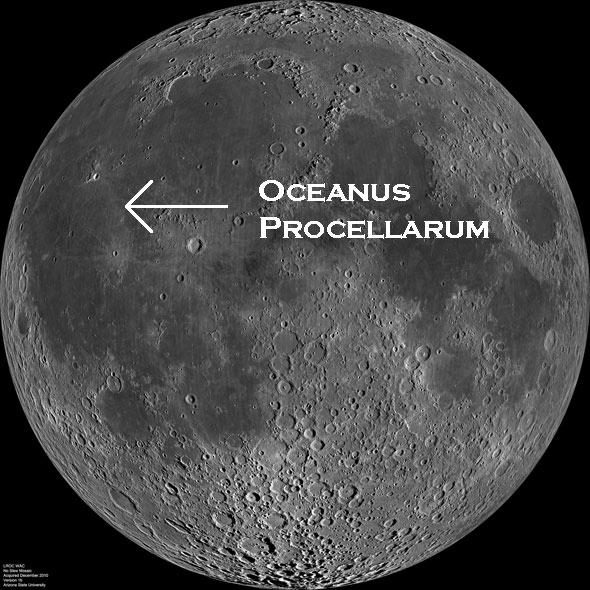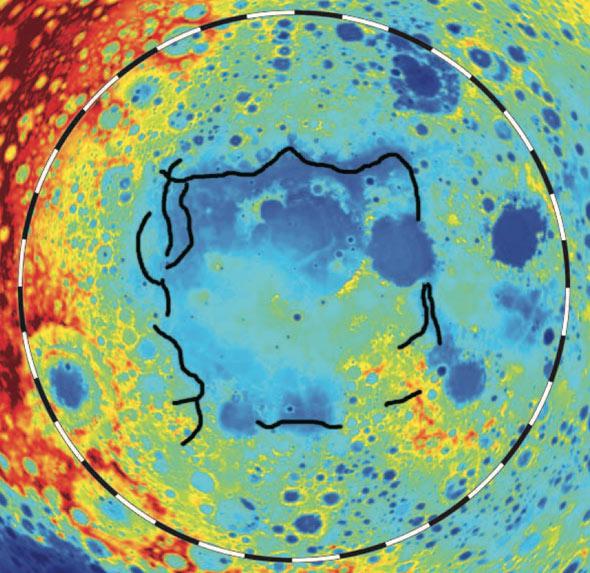There’s an old phrase: “To someone with a hammer, everything is a nail.”
Asteroids are the ultimate hammers. After all, an asteroid impact can certainly pound a nail into the toughest medium! Because of that they’re blamed for all sorts of features in the solar system. But a new paper claims that one of the largest features on the Moon—Oceanus Procellarum, the “Ocean of Storms”—was actually not caused by a giant impact, as has long been thought.
Instead, it may have been formed due to an enormous series of volcanic rifts.

Photo by NASA/GSFC/Arizona State University
Procellarum is a huge flattened region of the Moon, dark lowlands dominating the Moon’s northwest face. It’s part of the fabled “Man in the Moon” formation. The region is a good 3,200 kilometers (1,800 miles) wide, which is huge. The overall shape was always assumed to be circular, but to be fair it’s difficult to say.
It formed long ago, about 3.5 billion years ago, and subsequent impacts (some of which have been huge) have distorted the outer boundaries. Because of its huge size and assumed roundness, its origin has generally been attributed to something very large hitting the Moon, punching through the crust. Magma welled up, creating vast plains, which eventually became the Procellarum we see today.
But the new study challenges that. Researchers used gravity data to look at features in and below the surface, and get a different story. The data came from GRAIL, twin spacecraft that orbited the Moon in formation. The Moon isn’t a homogeneous sphere; it’s lumpy, with places under the surface with higher and lower densities. This means those regions will have higher and lower gravitational pull. As the first spacecraft flew over such a region, it would speed up or slow down relative to the second one. This could then be used to determine the density of the underlying terrain.
What they found was not what was expected: A series of long, narrow features that look like rift structures, places where the Moon’s crust is thinner, and which are generally associated with upwelling magma. The structures form a rough square or pentagon that neatly outlines the lowlands.

Diagram by Andrews-Hanna et al., from the journal paper
This changes the way they interpret the formation of Procellarum. Instead of a single huge impact, these rifts formed and magma started to seep (or more likely flood) through. It flowed downhill, toward the interior of the polygon. Eventually, the pressure from the weight of the overlying lava compressed the crust, closing the rifts, shutting off the flood. The lava plains cooled, and later impacts formed the other basins seen overlapping it.
The scale of this is mind-numbing: Imagine an eruption of lava so big and so long-lasting it flooded 2.5 million square kilometers of lunar surface! That’s an area a quarter the size of the entire United States.
Yikes.
Despite its apocalyptic nature, there’s a lot to like about this new idea. The observations make a neat fit, for one thing. For another, I’ve always had a problem with the impact idea; the size of the impact was so big it should’ve had lots of secondary effects. For example, the shock wave in the crust would have traveled around the Moon, converging on the spot on the opposite side (called the antipode). This dumps lot of energy there, and you should see chaotic, jumbled terrain in that area (this is seen with Mare Imbrium, or “Sea of Rains”, for example). Yet there’s no indication of such a feature.*
This paper just came out, and knowing scientists as I do, I expect there to be a lot of discussion and arguing over the data and results. That’s a rock-solid (har har) guarantee when a new idea challenges a long-established one, especially when it’s something as basic as the formation of a huge feature.
But that’s part of the fun! Now we have to figure out which idea is not just good, but better, and then think of ways of testing them both to compare them. One idea may win, or maybe both will (sometimes multiple causes form a single feature), or maybe a third idea will well out of the cracks.† Remember, this new idea was only made possible due to new ways of studying the Moon (GRAIL flew in 2012). The more we study our nearest cosmic neighbor, the more likely it is we’ll find surprises lurking just below the surface.‡
* Though I did find a paper saying the Procellarum may have been formed due to antipodal effects of the South Pole Aitken Basin, which is interesting.
† Yup. Couldn’t resist.
‡ See †.